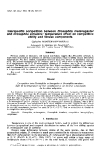
ISSN: 2615-9740
JOURNAL OF TECHNICAL EDUCATION SCIENCE
Ho Chi Minh City University of Technology and Education
Website: https://jte.edu.vn
Email: jte@hcmute.edu.vn
JTE, Volume 19, Special Issue 05, 2024
74
Influence of Heating Temperature on the Ink Transfer to Polymer Substrates in
the Retransfer Printing Process
Thi Kieu Nguyen Hoang
School of Materials Science and Engineering, Hanoi University of Science and Technology, Vietnam
Corresponding author. Email: nguyen.hoangthikieu@hust.edu.vn
ARTICLE INFO
ABSTRACT
Received:
28/05/2024
This study explores the effect of heating temperature on the ink transfer to
Poly(vinyl chloride) and Poly(ethylene terephthalate) substrates in a
specific retransfer printer. A notable correlation between heating
temperature and solid color density was observed. The color density
increases with heating temperature until reaching a critical threshold,
typically around 140°C. Beyond this threshold, color density begins to
decline due to ink penetration into the substrate, reducing ink film thickness
on the surface of the substrates. This critical temperature is predominantly
influenced by the properties of the ink rather than the characteristics of the
substrate. The experimental study also reveals that variations in
temperature-dependent ink transfer lead to noticeable color differences
compared to standard references. An optimal temperature range of 120°C
to 140°C was established, within which the process colors conform to the
ISO 12647 standard, achieving E values below 5. These results highlight
the importance of maintaining appropriate ink transfer conditions to ensure
precise color reproduction in printing processes.
Revised:
24/06/2024
Accepted:
06/09/2024
Published:
28/12/2024
KEYWORDS
Retransfer printing;
Ink transfer;
Color reproduction;
Plastic card printing:
Temperature effect.
Doi: https://doi.org/10.54644/jte.2024.1607
Copyright © JTE. This is an open access article distributed under the terms and conditions of the Creative Commons Attribution-NonCommercial 4.0
International License which permits unrestricted use, distribution, and reproduction in any medium for non-commercial purpose, provided the original work is
properly cited.
1. Introduction
Personalized intelligent cards have seen significant growth in the financial and retail sectors. These
cards require the highest image quality for security, flexibility, and efficiency, which can be achieved
through diverse card materials and a broad array of chip-encoding options [1].
Retransfer printing has emerged as a versatile and efficient technology for producing such cards, e.g.,
identification cards, credit cards, and access badges [2]. Unlike traditional direct-to-card (DTC) printers,
which use a thermal head to transfer the image through a dye ribbon (often by sublimation) directly onto
the card surface, retransfer printers carry out a two-step process. First, the image is printed onto the
transfer film using a digital printing technology, such as dye-sublimation or thermal transfer. Then, the
printed film is thermally transferred onto the plastic card. In this technology, the printhead never comes
into contact with the cards. Thus, compared to DTC printing techniques, retransfer printing offers
several advantages, including improved image quality, durability, and printability on a broader range of
card materials [3], [4]. Retransfer technology provides a breakthrough beyond DTC printing and is
expected to be 12 – 15% of the current printing market. The critical parameter of the ink-transferring
process is the heating temperature. It is understood that this parameter directly affects the level of dye
transfer to the substrate, resulting in color accuracy, density, and overall image quality [5] – [8]. Almost
all research has been conducted on how the temperature influences the performance of the ink on the
textile substrate. The literature identifies that the processing temperature can range from 138oC – 300oC
[9], presenting a wide range of operations. However, the results can not be fully applied to plastic cards
as the effect of temperature must comply with the substrate.
On the other hand, some works [8], [9] reported the level of dye penetration into the polymer
substrate but did not describe how it influences ink performance on the substrates. Therefore, this study
investigated the effect of temperature on the ink transfer to polymer substrates in the retransfer printing
process. The study explores the fundamental processes that enable the industry to select an optimum
condition, including materials, pressures, and temperature.







